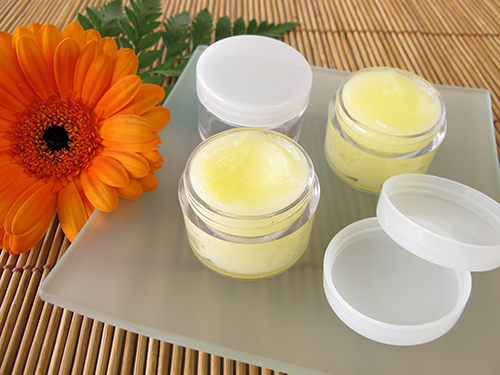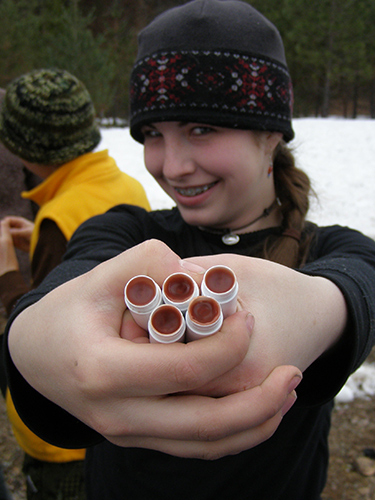Natural Lip Balm Recipe
I love using lip balm made from my very own lip balm recipe. Even if I'm not dehydrated and my lips are not chapped I still love putting it on my lips. The smooth texture, the subtle aroma, the soft golden color of the balm not to mention the powerful medicinal properties of the herbs in each vial has made me pine after finding a handy and multi-purpose lip balm recipe I can reproduce anytime. So that's what I did. I've made salves. I've made oils. I've made lotions and creams, shaving cream and face washes but lip balm is my absolute favorite. Here's why.

The Benefits of Balms
Lip balm is truly magic. It's a champion packed into a tiny tin. It softens when applied to your skin, provides a healing, nourishing, and comforting relief to dry chapped lips. It soothes and moisturizes the thinner skin of your lips faster than the rest of your facial skin and it helps keep your lips protected from the weather and the elements, especially the sun's rays, by retaining the moisture that's already there. Can we ever be thankful enough for such an incredible balm that can do all this?
Many lip balms are made with artificial ingredients, chemicals and synthetic preservatives, meant to prolong their shelf life and make the manufacturing process more efficient. The truth is that process is degenerative for both our bodies and the body of the Earth. Crafting your own lip balm gives you the freedom of knowing exactly what's in it and therefore knowing what's going on your lips. Taking a lip balm recipe and making some from scratch offers a sense of simplicity, personal connection, and satisfaction that you can't get from buying it from a store.
Lastly many lip balms cost quite a bit of money nowadays. Making your own is inexpensive and costs pennies in comparison. You not only save money over time but you also get the experience and knowledge of making it yourself.
The Versatile, Natural Lip balm recipe
This is a very simple, natural, yet versatile lip balm recipe that is a perfect place to start. Whether you've made lip balms before or this is your first time it's always good to have a basic recipe that you can add or change over time as you become familiar with it.
Ingredients:
- 1 Tbsp. shea butter
- 1 Tbsp. coconut oil
- 1 - 2 Tbsp. beeswax (depending on how creamy or firm you want your lip balm)
- 1 Tbsp. almond oil (or some other kind of carrier oil like sunflower or jojoba)
- 6 or more lip balm tins or tubes, approximately
Directions:
Using a double boiler begin boiling some water and melt beeswax and oils together in the top of the boiler. Remove from heat. Thoroughly stir and mix. Using a funnel slowly and carefully pour the liquid into your lip balm tubes, canisters, or jars. Let sit at least 20 minutes or more until lip balm has cooled and congealed completely. This lip balm recipe makes about a half dozen tubes of lip balm. There are a variety of small containers or jars to use, including lip balm tubes.

Recommended Herbs for your lip balm recipe
There are many great herbs that you can add to your lip balm recipe for adding potent medicine to it. All you need to do is soak your fresh or dried herbs in some oil (I recommend olive oil as the first choice). For dried herbs soak them in oil for 7 - 10 days. For fresh herbs soak plants in oil for up to 4 weeks. Make sure your herbs are kept soaking under the oil so no air gets to them or they could mold. You can shake or stir up your jar occasionally. Then strain the herbs from the oil and you've got your herbal oil ready to use for making lip balm. Here are some medicinal herbs that are great for both oil and lip balm.
- Calendula - great for cracked, chapped lips
- Mullein - good for painfully dry lips
- Yarrow - fantastic for sores, wounds and bruises and stops bleeding lips
- St. John's wort - good for bruises, wounds, cuts and infections
- Plantain - heals cuts and scratches and speeds recovery of blistered lips
- Heal-all - If you've got a wound, it will heal it, such as cold sores and other wounds
- Mint - a cooling and calming herb for your lips
- Elder flower - traditionally used in salves to treats cuts and skin irritations
- Comfrey - soothes the irritated tissue in your lips
- Arnica - great at bringing comfort to irritated, sore dry lips
- Chickweed - can ease aggravated, swollen and sunburnt lips
- Lemon Balm - a calming herb that alleviates pain and swollenness from tender lips
- Cottonwood bud resin - helps heal achy chapped lips
Lip Balm as Medicine
Lips are regularly exposed to all kinds of environmental conditions including wind, sun, dry air, and other factors. Food, drinks, the tongue, another person's lips and many other factors contribute to your lips getting a lot of activity every day. As a result, lips can become dry, sore, crusty, cracked, chapped and/or often irritated. This is why lip balms are really medicinal rescuers that offer healing.
It's important to remember how significant our lips are and what they do for us. They help us breath, articulate words, process sensations, eat, laugh, kiss, and as babies, breast feed. Lips are a protective gateway to the mouth. They need to be regularly nourished by fresh food, vitamins and minerals and, lip balm.
In the lip balm recipe I gave you one of the ingredients was beeswax. Remember that beeswax helps seal in moisture and helps your lips to not evaporate that moistness. Fragrances in many lip balms also reduce moisture so that's why I'm suggesting you make your own herbal oils for boosting medicine and fragrance into your lip balm as well.
Preservation and Storage
Vitamin E is a nutrient found in spinach, seeds, almonds and many other foods. It's an ingredient you can add to your lip balm recipe. It will act as a preservative to keep it from going bad, plus you're getting the added benefit of maintaining healthy skin as it protects the cells in your skin.
Other ways of storing your lip balm well are to pour it into a dark glass jar and then keep it in a cool dark cupboard capped tight. Often lip balms and salves can melt and then reform from constantly changing temperatures. This often causes lip balms to go rancid. When in doubt, know that vitamin E will certainly help preserve your lip balm and keep it fresh even amidst heat surrounding it.
In Closing
Our lips are exquisitely sensitive and can detect temperature and texture that many other parts of our body can't. They deserve the best lip balm you can offer them. Why not take the time to go out and foster a deeper connection with nature, weaving in gratitude, relationship with place, curiosity, and passion into your lip balm?
By taking this lip balm recipe and making it your own with herbal medicines you've gathered, you're investing in a deeper relationship with nature and your own health simultaneously. You, and your lips, are worth that connection!
Additional Resources
- Handcrafting Artisan Salves and Lip Balms from your Kitchen by Alan Bullington
- Peterson's Field Guide to Western Medicinal Plants and Herbs by Christopher Hobbs and Steven Foster
- Peterson Field Guide to Medicinal Plants and Herbs of Eastern and Central North America by Steven Foster and James A. Duke
Interested in being personally mentored in Edible Wild and Medicinal Plants, on a transformational journey of connection to nature, community, and self?
Check out the Twin Eagles Wilderness Immersion Program.
comments powered by Disqus
Return from Lip Balm Recipe to Edible Wild Plants
Return from Lip Balm Recipe to Wilderness Survival (homepage)
Track Us